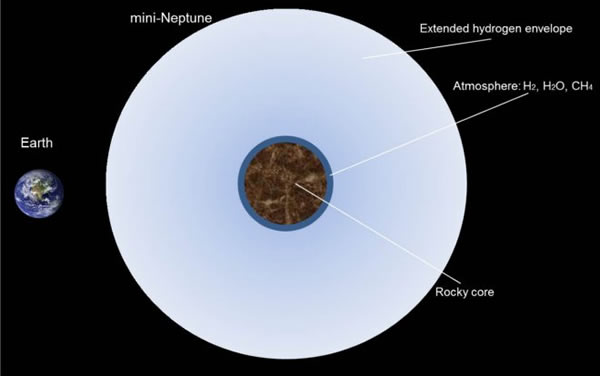Major Bummer: Super-Earths May Be Mini-Neptunes
Major Bummer: Super-Earths May Be Mini-Neptunes
There’s a new study out suggesting that some of those larger-than-Earth rocky exoplanets, a.k.a. super-earths, are more like mini-Neptunes. This, in my honest opinion, is a major bummer.
For many years super-earth’s have been my favorite flavor of exoplanet, for several reasons. One is that they are arguably better places for complex life to evolve than Earth. Yes, you read that right: Super-earths could possibly make Earth looks like a marginally life-supporting planet.
It’s all because of plate tectonics. On Earth the ever-shifting plates in Earth’s crust make this a very good place to evolve. There are always mountains being built and eroding away, burying plenty of excess carbon along the way and removing it from the atmosphere and moderating the climate (until some overconfident species comes along and starts digging up all that carbon and flinging it back into the atmosphere, mucking things up, but that’s another story).
Tectonics also leads to lots of volcanoes. And volcanoes are cool because they not only provide a potential place for life to start, but they make organisms work hard to evolve or die. We owe our existence, at least in part, to a massive flood basalt eruption in India at the end of the Cretaceous, which likely primed dinosaurs for the asteroid impact that then finished them off. So if you like the existence of humanity, thank a volcano.
It’s not clear, however, that Earth was destined to have plate tectonics. There has been a lot of research and speculation over the years about what started the process on Earth. Some researchers suspect a massive asteroid impact early in Earth’s history initiated it all. And had that not happened, Earth would be a very different place.
How does this relate to super-earths? The cool thing about super-earths is that because they are larger than Earth, they have a lot more internal heat. The slow release of that heat should theoretically make plate tectonics absolutely necessary. That, in turn, makes the evolution of complex life all the more likely (for more info about where all the heat comes from, see this nice explanation).
Just to drive the point home, consider Mars. Think of the Red Planet as the opposite of a super-earth: a mini-Earth. It may possibly have had enough heat early on for plate tectonics, but has since cooled down and become a rigid, unchanging planet. Our little Earth is a planet that barely managed to do it and there could be all kinds of big fat super Earth’s out there with massive, high-gravity alien animals that would make us look like fragile little stick figures.
But that brings me, finally, to the new study by Helmut Lammer of the Austrian Academy of Sciences. These folks are suggesting, to my dismay, that the super-earths that have been detected out there amongst other exoplanets, are surrounded by vast, deep hydrogen-rich atmospheres and unlikely to be Earth-like at all. They are, instead, mini-Neptunes, they said. The study is published in the journal Monthly Notices of the Royal Astronomical Society.
As the diagram above shows, their super-earth model has a small rocky core with an inner atmosphere of methane, water and hydrogen and an extended hydrogen envelope. To come to this vision of mini-Neptune, Lammer and his team looked how the stellar radiation affected the upper atmospheres of super-earths orbiting the stars Kepler-11, Gliese 1214 and 55 Cancri.
These exoplanets orbit very close to their stars. The new model suggests that extreme ultraviolet light of the stars heats up and expands the gassy envelopes of these exoplanets to several times the radius of each planet. So rather than becoming more like the Earth, the super-earths may more closely the giant planets Neptune and Uranus.
Just to rub salt into the wound, these scientists point out that super-Earths further out and in the ‘habitable zone’ of their stars (where the temperature would allow liquid water to exist) are even less likely to be Earth-like, because they would have thick atmosphere as well, with even less chance of it being thinned by a stellar wind.
Like I said: it’s a bummer.
Feb 6, 2013 12:46 PM ET by Larry O'Hanlon












